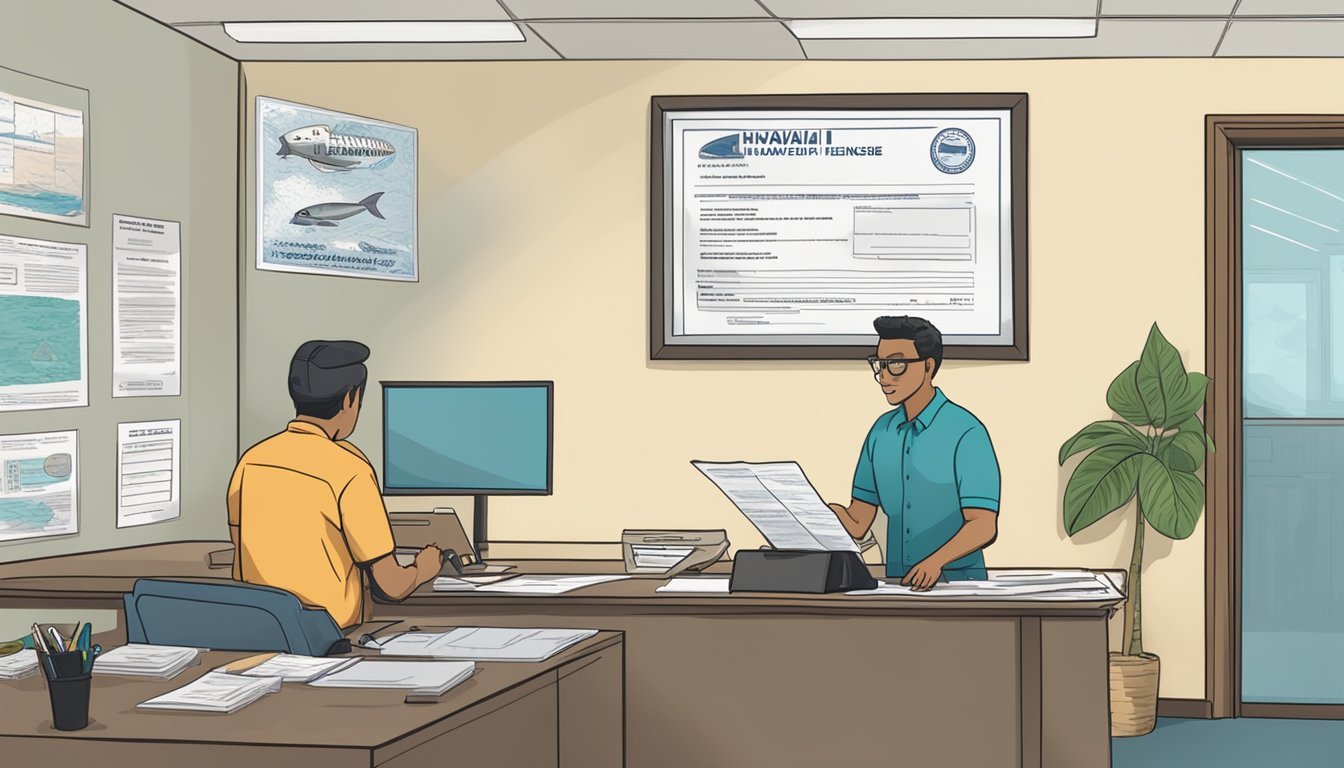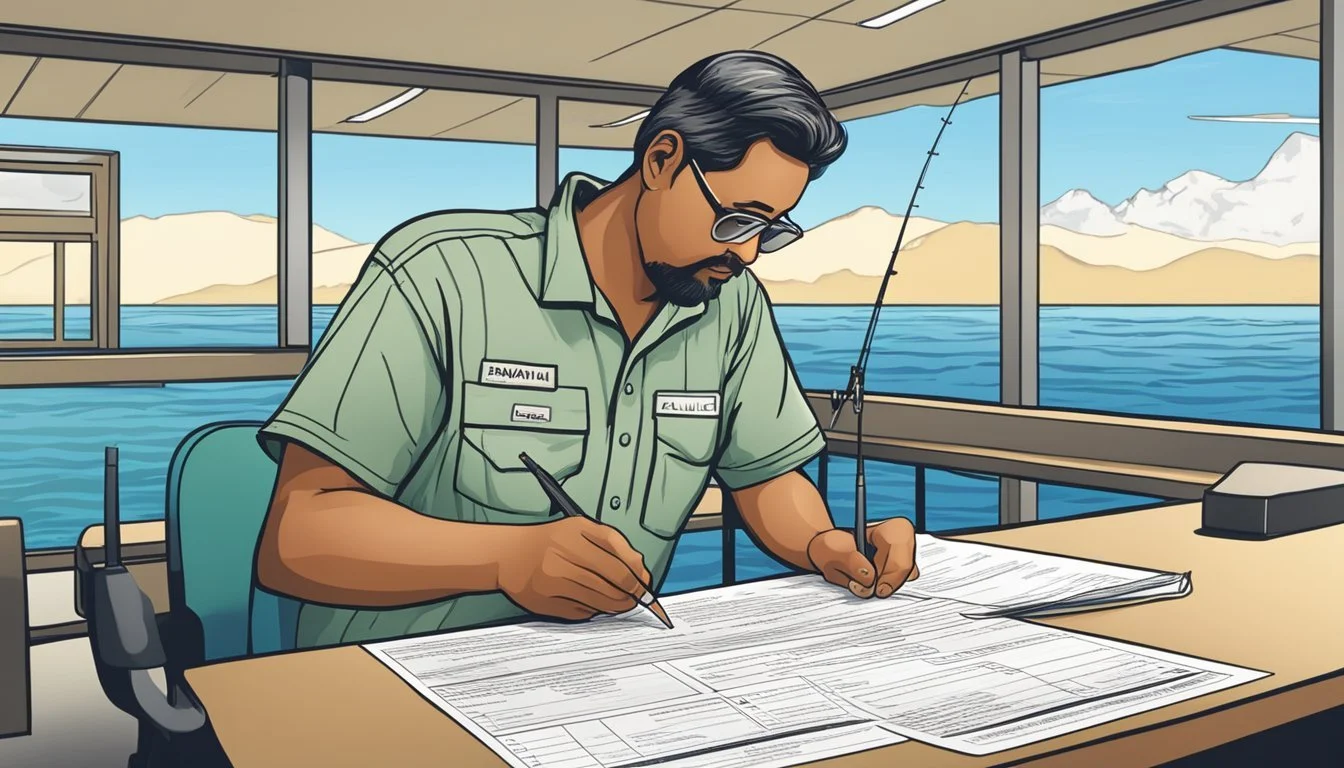How to Get a Hawaii Saltwater Fishing License
Your Essential Guide
Obtaining a saltwater fishing license in Hawaii is a straightforward process tailored to various types of fishing activities and types of fishermen, whether one is a resident or a visitor. The state of Hawaii's Division of Aquatic Resources (DAR) oversees the management of marine resources, and accordingly, it is the authority that issues fishing licenses and permits. For non-commercial recreational saltwater fishing, Hawaii currently does not require licensing for residents. However, non-residents must be aware that legislation enforcing a marine recreational fishing license is in place, targeting visitors who wish to engage in this activity.
For commercial fishing endeavors, individuals and businesses are required to apply for a commercial marine license. The application process is accessible online through the Hawaii Department of Land and Natural Resources, ensuring a user-friendly experience for potential applicants. Licensing fees vary depending on several factors including the type of license, the applicant's residency status, and the time frame for which the license is valid. These measures ensure the sustainable use of Hawaii's marine resources and help maintain the ecological balance of the aquatic environments.
In addition to the legal requirements, it's important for all aspiring fishermen to understand the specific terms and conditions that come with the different licenses. These may include seasonal restrictions, such as the closed season for Kona Crab (how long does crab last?) and Lobster (What wine goes well with lobster?), meant to preserve the populations during vulnerable periods. Keeping informed about the most recent regulations and terms is crucial, as these can change and have direct implications on fishing activities in Hawaii's saltwater environments.
Understanding Hawaii's Fishing Licenses
Hawaii offers a variety of fishing licenses to suit different purposes, ranging from recreational to commercial activities. It is essential for anglers to understand and comply with the state's licensing requirements.
Different Types of Licenses
Hawaii has established a variety of fishing licenses to ensure that the ecosystem is preserved while still providing ample opportunities for anglers. These vary depending on whether one is a resident, a non-resident, or engaging in commercial fishing activities.
Marine Recreational Fishing License
For those interested in saltwater fishing for non-commercial purposes, Hawaii currently does not require a Marine Recreational Fishing License. However, anglers should stay informed as regulations can change.
Freshwater Game Fishing License
A Freshwater Game Fishing License is mandatory for those wishing to fish (What wine goes well with fish?) in Hawaii's freshwater locations. This applies to both residents and non-residents and is essential for targeting species in inland waters.
Resident - $6
Non-Resident - Fees vary
Minor - $4
Non-Resident Fishing Licenses
Non-Resident Fishing Licenses are designed for visitors who wish to fish in Hawaii's waters. The fees for these licenses vary and are typically higher than resident fees, reflecting the temporary use of Hawaii's natural resources.
Range: $20 to $70
Combination Licenses
Hawaii may offer combination licenses that allow for both saltwater and freshwater fishing. These licenses simplify the process for anglers who wish to engage in various types of fishing during their visit or stay.
Licenses for Specific Activities
There are licenses tailored for specific activities such as commercial fishing or collecting fish for a personal home aquarium. For instance, the Bait License, which costs $50, is a requirement for commercial fishers who use small mesh nets to catch select baitfish species.
Commercial fishing: License required for various activities
Personal home aquarium collection: License and regulations apply
It's crucial for anglers to check with the Hawaii Department of Land and Natural Resources for the most current licensing information and to ensure compliance with state fishing regulations.
Where to Purchase Your Hawaii Fishing License
Selecting the appropriate avenue to acquire your Hawaii fishing license is crucial for a seamless start to your fishing adventure. Whether opting for the convenience of an online transaction, visiting a local agent, or going to a DLNR office, each option provides a reliable means to ensure compliance with Hawaii’s fishing regulations.
Online Purchase
Purchasers can efficiently obtain their fishing license through the Hawaii.gov portal. The application process is streamlined and makes it possible to secure a fishing license from the comfort of one’s home. Simply head to the Department of Land and Natural Resources (DLNR) website and follow the prompts to complete the transaction.
Local Fishing License Agents
Physical licenses are available at various local fishing license agents. These agents include tackle shops, sporting goods stores, and other designated retailers. They are knowledgeable and can provide firsthand information about the specifics of the licenses offered. A list of authorized agents can be found on the DLNR website.
Department of Land and Natural Resources (DLNR) Office
For individuals preferring in-person interactions, visiting a Department of Land and Natural Resources office can be particularly helpful. One can obtain their fishing license directly, ask questions, and get additional insights into fishing in Hawaii. DLNR offices are staffed with professionals prepared to assist with all licensing needs.
Rules and Regulations
Hawaii's fishing regulations are designed to sustainably manage and protect its marine resources. It is crucial for anglers to understand and comply with these rules to ensure the conservation of Hawaii's aquatic life.
General Fishing Regulations
Hawaii does not require a marine recreational fishing license for its residents. However, a license is under consideration for non-resident visitors. The Division of Aquatic Resources (DAR) oversees the enforcement of fishing regulations, and all anglers should check for any updates before fishing.
Size and Catch Limits
Hawaii's fish size and limits are specific to each species, designed to prevent overfishing and to conserve fish populations. It is vital to comply with the established size, bag, and season limits. These regulations are regularly updated, so anglers should refer to the latest administrative rule provided by the DAR.
Protected Areas and Species
Certain areas are designated as wildlife refuges, Fish Replenishment Areas (FRAs), Marine Life Conservation Districts (MLCDs), and Public Fishing Areas (PFAs). Fishing in these areas may be restricted or prohibited to protect the various aquatic species. The DAR provides comprehensive maps and descriptions of these protected locations.
Equipment and Gear Restrictions
Legal gear or tackle in Hawaii includes rod and reel, handline, throw net, and spear, among others. Illegal methods, such as the use of explosives or poisons, are strictly prohibited. The DAR defines acceptable gear types and use in its regulations to reduce harm to non-target species and coral reefs. Compliance with gear restrictions is essential for the preservation of the marine ecosystem.
Understanding Licensing Fees
Acquiring a Hawaii saltwater fishing license involves specific fees that one should be aware of prior to applying. Whether you are a resident or non-resident, the cost of your license will vary, and in some cases, you may require additional permits.
Costs for Residents
Residents of Hawaii can expect to pay a reduced fee for a saltwater fishing license. As of the most recent updates, fees for residents are structured to encourage local fishing activities. Annual licenses for residents provide a cost-effective option for those who fish frequently.
Costs for Non-Residents
For non-residents, the fishing license fees are typically higher. This tiered structure aims to support conservation efforts while still providing access to Hawaii's fishing resources. Non-residents should plan for these increased costs when budgeting for fishing activities in Hawaii.
Additional Permits and Fees
Certain areas, such as Wahiawa Public Fishing Area, may require an entry permit in addition to the standard saltwater license. Additionally, specialized permits may be necessary for specific types of fishing activities. It is crucial to check for any additional permits and fees that may apply to your planned fishing expedition to ensure full compliance with local regulations.
Renewing and Managing Your License
For saltwater fishing enthusiasts in Hawaii, keeping their fishing license up to date is a straightforward process. The state's online licensing system simplifies renewals and amendments to existing licenses.
Online Renewals
Fishermen can renew their licenses through the Division of Aquatic Resources directly via their online services. To complete a renewal, license holders must provide personal identification details, with the last four digits of their social security number required for verification purposes. Registration for existing licenses must be done annually, ensuring continued access to Hawaii's marine resources.
License Amendments
If license holders need to add a license type or update their personal information, Hawaii's licensing system allows for such amendments. This process is designed to ensure that all fishermen's information is accurate and up to date, reflecting any new qualifications or changes in fishing activity.
Special Cases and Considerations
When applying for a Hawaii saltwater fishing license, certain groups such as visitors, military personnel, and those fishing from private property need to consider specific regulations and provisions that may apply to them.
Visitors
Visitors to Hawaii must obtain a marine recreational fishing license. As of recent legislation, all non-residents need to secure a license before engaging in fishing activities. The fee structure for non-residents is as follows:
One-day license: $20
Seven-day license: $40
Annual license: $70
Children under the age of 15 are exempt from needing a license.
Military Personnel
Military personnel stationed in Hawaii are not exempt from fishing license requirements. However, they may be eligible for resident rates if they can demonstrate presence in the state for other than temporary or transitory purposes. They should check with the Hawaii Division of Aquatic Resources for any military-specific considerations or exceptions.
Fishing From Private Property
Individuals fishing from private property should verify whether a license is required. In some cases, fishing without a license is permitted if they are angling in the saltwater directly connected to their property. However, this exemption might not apply to all bodies of water, and it is crucial for property owners and their guests to confirm the specific rules that govern their situation.
Contributing to Hawaii's Aquatic Resources
Obtaining a saltwater fishing license in Hawaii not only ensures legal fishing activities but also plays a crucial role in supporting local aquatic resource management and conservation initiatives.
The Role of Licensing Revenues
Division of Aquatic Resources (DAR) oversees the issuance of commercial marine licenses in Hawaii. The fees collected from these licenses contribute to a special fund, which is instrumental for the department's operational budget. This income is directed towards several key areas:
Resource Management: Implementing and enforcing regulations that sustain fish populations and habitats.
Research: Supporting scientific studies for the preservation of aquatic life.
Revenues generated from license fees are an essential part of the state's strategy to maintain and enhance marine ecosystems and ensure sustainable fishing practices.
Supporting Conservation Efforts
The funds collected from licensing are allocated to projects and initiatives aligned with the conservation mission of DAR. Moreover, the Division of Conservation and Resources Enforcement (DOCARE) relies on these resources to enforce fishery laws and protect marine resources across Hawaii.
Key conservation efforts supported by licensing fees include:
Habitat Restoration: Reviving coastal and underwater habitats that are vital for marine species.
Education: Creating awareness and understanding among anglers and the general public about the importance of marine conservation.
Regulation Enforcement: Ensuring compliance with fishing regulations through surveillance and patrols.
Licenses play a foundational role in safeguarding Hawaii’s marine life and aquatic resources for future generations.
Fishing Locations and Opportunities in Hawaii
Hawaii offers a diverse range of fishing experiences, from the rich pelagic waters ideal for saltwater fishing to serene freshwater streams. Here, anglers can find a variety of both saltwater and freshwater spots, as well as opportunities for charter and deep-sea fishing excursions.
Saltwater Fishing Spots
Oahu:
Waikiki Diamond Head Shoreline: Renowned for shoreline fishing, especially around dawn and dusk.
Waialua Bay Pier: A hub for catching a wide array of saltwater species.
Kauai:
Nawiliwili Harbor: Offers a protected fishing location with access to many fish types.
Freshwater Fishing Areas
Hawaii's Freshwater Scenes:
Waiakea Pond: A prime spot for anglers looking for freshwater fishing on the Big Island.
Freshwater Streams: Pockets of freshwater streams across the islands are home to fishes like the smallmouth bass and tilapia.
Charter and Deep-Sea Fishing
Fishing Charter: Boats can be hired for exclusive fishing trips, with experienced crews to guide through the best deep-sea sites.
Kona Coast (Big Island): Internationally recognized for marlin fishing and other deep-sea species.
Pearl Harbor: While historically significant, it has restricted access for fishing due to its military significance.
Anglers should always check for any regulations or restrictions before planning their fishing trips in these locations.
Popular Fish Species in Hawaii
Hawaii offers a variety of sought-after fish species, providing unique opportunities for both deep sea and freshwater fishing enthusiasts.
Deep Sea Fishing Targets
Marlin: The waters around Hawaii are renowned for their marlin, particularly off the Kona side of the Big Island. Anglers target several species including the majestic Blue Marlin, which made history with a world-record catch. The islands also host Spearfish and Striped Marlin, adding to the appeal of Hawaii as a premier marlin fishing destination.
Yellowfin Tuna (Ahi): This species is highly prized for both its fight and its place in Hawaiian culinary tradition.
Kona Crab: Savored by locals, Kona crab is a flavorful catch that's native to Hawaiian waters.
Common Freshwater Species
Peacock Bass: Known locally as Tucunare, peacock bass populate the freshwater environments of Hawaii. This species is recognized by its vibrant colors and is a favorite among freshwater anglers.
Ama’ama (Hawaiian Mullet): This indigenous species is venerated in traditional Hawaiian culture. Ama’ama are commonly found in the estuaries and nearshore waters of the islands.
Despite the diversity of species, most saltwater fishing does not require a license, while freshwater fishing does. It is imperative that anglers check the latest regulations before heading out to fish, as these can change and specific areas may have unique rules or may be privately owned, requiring particular permissions for access.
Cultural Significance of Fishing in Hawaii
In Hawaii, fishing is more than just an activity; it is woven into the cultural tapestry. The earliest Polynesians recognized the bountiful Hawaiian waters as crucial to survival, incorporating fishing deeply into their societal structures and daily lives. They managed the ecosystem with sustainable practices, using a variety of sophisticated techniques tailored to the island's diverse marine life.
Fishing Methods: Traditional methods included the use of fishing lines, hooks, and nets, some fashioned from local materials. Fishermen were skilled in spearfishing and took advantage of the tidal patterns and lunar cycles to optimize their catches.
Loko I'a: The ingenuity of native Hawaiians is showcased by fishponds known as loko i'a. These coastal ponds, expertly constructed to harbor fish, were staples of an integrated food production system.
Cultural Practices: Fishing was surrounded by rituals and kapu (taboos), which underscored its importance to Hawaiian society. Each step, from selecting the right time to fish to preserving and preparing the catch, was infused with cultural significance.
Economic and Social Roles: Fish and fishing practices played significant economic and social roles, providing sustenance and trade goods. They also helped define social structure, with certain fish reserved for royalty.
Spiritual Significance: Freshwater, or wai, and the sea were revered, often reflected in chants and hula, where fishing narratives and the respect for the ocean were artistically expressed.
Today, these historical underpinnings shape modern fishing activities. They are seen in the respect for the environment that is expected of those engaging in fishing throughout Hawaiian waters, reflecting a heritage that honors the past while looking to the future.
Additional Resources and Information
To ensure a fulfilling fishing experience in Hawaii's waters, one can access a variety of resources. These materials offer guidance on best practices, fishing techniques, and legal requirements, and provide direct points of contact for regulatory agencies.
Fishing Guides and Tutorials
For those interested in deep-sea fishing or wanting to familiarize themselves with local techniques and regulations, a wealth of fishing guides and tutorials are available. These resources cater to both beginners and experienced anglers:
Division of Boating and Ocean Recreation: Provides in-depth guidelines regarding safe and responsible fishing practices in Hawaii's vast ocean waters.
Hawaii Fishing Guides: A collection of publications and online resources that include tips for successful fishing, species identification, and conservation practices.
Contact Information for DLNR and DOCARE
Direct contact with the Department of Land and Natural Resources (DLNR) and the Division of Conservation and Resources Enforcement (DOCARE) can be indispensable for up-to-date information and clarification on fishing licenses and regulations:
DLNR Division of Aquatic Resources
Website:
http://dlnr.hawaii.gov/dar/Phone:
(808) 587-0100
DOCARE
Website:
http://dlnr.hawaii.gov/docare/Phone:
(808) 587-0077
Both entities are equipped to assist with queries related to fishing licenses for residents and non-residents, vessel registration, and fishing reports. Their online portals also offer downloadable forms and applications for various fishing-related licenses and permits.











